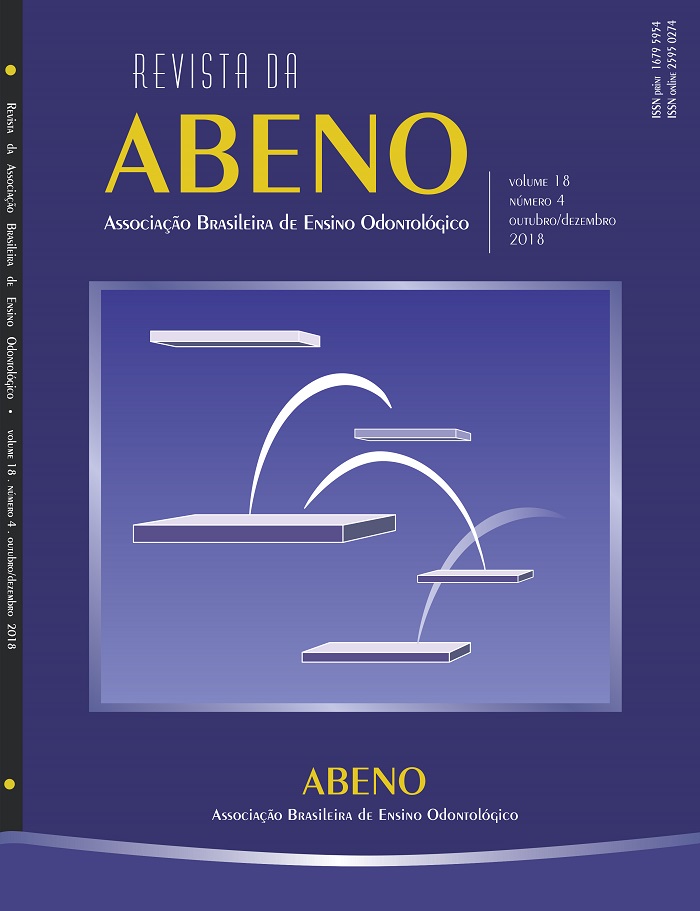Implementation and assessment of a blended learning course in Biochemistry for Dental students
DOI:
https://doi.org/10.30979/rev.abeno.v18i4.599Keywords:
Education. Dentistry. Active Methodologies.Abstract
The aim of the present study was to assess the performance of dental students in a blended learning course in biochemistry. Two groups were assessed: one made up of students who took the conventional course (CC) in biochemistry in 2015, and one that attended the blended learning (BL) course in biochemistry in 2016. The learning goals, the syllabus, and the assessments were the same for both groups. Students’ performance was checked by individual bimonthly classroom-based tests with similar levels of difficulty between the groups. The results were analyzed by two-way ANOVA and the level of significance was set at 0.05. A total of 198 students (54.4% female and 45.5% male) participated in the study in 2015, whereas 148 students (52.7% female) participated in the study in 2016. Students from the BL group had a better performance in the 1st, 2nd, and 3rd bimesters (p<0.05). The annual average of students in the BL group was also better than that of the CC group. This study therefore suggests that the blended learning method provides students with larger knowledge gain than does the classroom-based method.
Downloads
References
Brasil. Conselho Nacional de Educação. Câmara de Educação Superior. Resolução CNES/CES 3, de 19 de fevereiro de 2002. Institui Diretrizes Curriculares Nacionais do Curso de Graduação em Odontologia. Diário Oficial da União: Brasília; 2002.
Tsai CC, Chai CS. The "third"-order barrier for technology-integration instruction: implications for teacher education. Australas J Educ Tec. 2012; 28(6):1057-60.
Ertemer AP. Addressing first- and second-order barriers to change: Strategies for technology integration. Educ Technol Res Dev. 1999; 47(4):47-61.
Fregona C, Sadza A. Blended learning. In: Enhancing Teaching Practice in Higher Education. 2016; 91-106.
Duhaney DC. Blended learning in education, training, and development. Performance Improvement. 2004; 43(8):35-8.
Bridges S, Chang JWW, Chu CH, Gardner K. Blended learning in situated contexts: 3-year evaluation of an online peer review project. Eur J Dent Educ. 2014; 18(3): 170-9.
Driscoll Blended learning: Let’s get beyond the hype. E-learning. 2002; 1(4): 1-3.
Khalil MK, Abdel Meguid EM, Elkhider IA. Teaching of anatomical sciences: A blended learning approach. Clin Anat. 2018; 31(3):323-9.
Shang F, Liu CY. Blended learning in medical physiology improves nursing students' study efficiency. Adv Physiol Educ. 2018; 42(4):711-7.
Lang FK, Bodner GM. What the biochemistry education research literature can tell university-level biochemistry instructors. FASEB J. 2017; 31(1), Supplement 1.
Nelson DL, Cox MM. Princípios de Bioquímica de Lenhinger, 6a ed, 2014; Porto Alegre, Artmed.
Bloom, B. S.; Engelhart, M. D.; Furst, E. J.; Hill, W. H.; Krathwohl, D. R. (1956). Taxonomy of educational objectives: The classification of educational goals. Handbook I: Cognitive domain. New York: David McKay Company.
Van Merriënboer JJ, Sweller J. Cognitive load theory in health professional education: design principles and strategies. Med Educ. 2010; 44(1): 85-93.
Minder SP, Schmitz FM, Schär SG. Online formative assessment in a medical PBL-curriculum. In: Isaias P, Ifenthaler D, Sampson GD, Spector MJ, editors. Towards learning and instruction in Web 30: Advances in Cognitive and Educational Psychology. New York, NY: Springer New York;
Minder SP, Weibel D, Wissmath B, Schmitz FM. Do students achieve the desired learning goals using open-book formative assessments? Int J Med Educ. 2018; 9:293-301
Pahinis K, Stokes CW, Walsh TF, Cannavina G. Evaluating a blended-learning course taught to different groups of learners in a dental school. J Dent Educ. 2007; 71(2): 269-78.
Maresca C, Barrero C, Duggan D, et al. Utilization of blended learning to teach preclinical endodontics. J Dent Educ. 2014; 78(8): 1194-204.
Rizvi NF, Gulzar S, Nicholas W, Nkoroi B. Barriers in adopting blended learning in a private university of Pakistan and East Africa: faculty members’ perspective. M Health. 2017; (5):3-18.
Snoeyink R, Ertmer PA. Thrust into technology: how veteran teachers respond. J Educ Tech Syst. 2001; 30(1): 85-111.
Butler DL, Sellbom M. Barriers to adopting technology for teaching
and learning. Educause Quarterly. 2002; 25(2): 22-8.
Downloads
Published
How to Cite
Issue
Section
License
Autores que publicam nesta revista concordam com os seguintes termos:
a) Autores mantém os direitos autorais e concedem à revista o direito de primeira publicação, com o trabalho simultaneamente licenciado sob a Licença Creative Commons Attribution que permite o compartilhamento do trabalho com reconhecimento da autoria e publicação inicial nesta revista.
b) Autores têm autorização para assumir contratos adicionais separadamente, para distribuição não-exclusiva da versão do trabalho publicada nesta revista (ex.: publicar em repositório institucional ou como capítulo de livro), com reconhecimento de autoria e publicação inicial nesta revista.
c) Autores têm permissão e são estimulados a publicar e distribuir seu trabalho online (ex.: em repositórios institucionais ou na sua página pessoal) a qualquer ponto antes ou durante o processo editorial, já que isso pode gerar alterações produtivas, bem como aumentar o impacto e a citação do trabalho publicado (Veja O Efeito do Acesso Livre).






